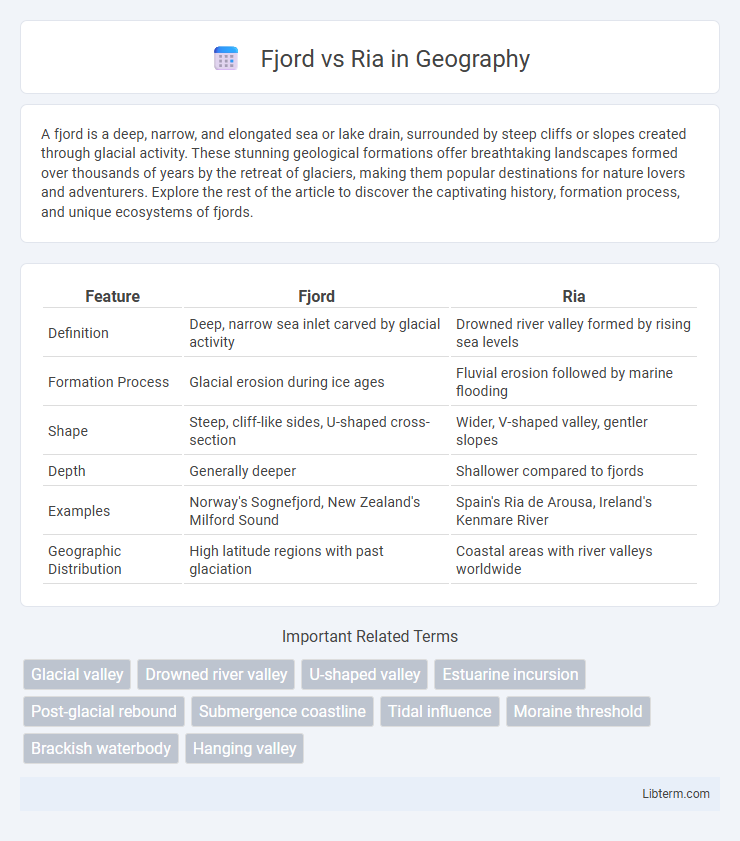A fjord is a deep, narrow, and elongated sea or lake drain, surrounded by steep cliffs or slopes created through glacial activity. These stunning geological formations offer breathtaking landscapes formed over thousands of years by the retreat of glaciers, making them popular destinations for nature lovers and adventurers. Explore the rest of the article to discover the captivating history, formation process, and unique ecosystems of fjords.
Table of Comparison
| Feature | Fjord | Ria |
|---|---|---|
| Definition | Deep, narrow sea inlet carved by glacial activity | Drowned river valley formed by rising sea levels |
| Formation Process | Glacial erosion during ice ages | Fluvial erosion followed by marine flooding |
| Shape | Steep, cliff-like sides, U-shaped cross-section | Wider, V-shaped valley, gentler slopes |
| Depth | Generally deeper | Shallower compared to fjords |
| Examples | Norway's Sognefjord, New Zealand's Milford Sound | Spain's Ria de Arousa, Ireland's Kenmare River |
| Geographic Distribution | High latitude regions with past glaciation | Coastal areas with river valleys worldwide |
Understanding Fjords: Definition and Formation
Fjords are deep, narrow inlets of the sea carved by glacial activity, typically characterized by steep cliffs formed during the last Ice Age as glaciers retreated and seawater flooded the valleys. These formations are unique to regions with past or present glaciation, creating dramatic landscapes with profound depths and U-shaped cross-sections. In contrast to rias, which are drowned river valleys, fjords owe their distinct shape to glacial erosion rather than fluvial processes.
What is a Ria? Key Features and Origins
A ria is a coastal inlet formed by the partial submergence of an unglaciated river valley, resulting in a drowned river valley with a characteristic funnel shape. Key features of rias include their branching pattern resembling river tributaries, gentle slopes, and increasing depth towards the sea, often creating natural harbors. Originating from rising sea levels that flood river valleys, rias are commonly found in areas with tectonic stability and a lack of glacial activity, contrasting with fjords formed by glacial erosion.
Geological Processes Behind Fjords
Fjords form through glacial erosion, where massive ice sheets carve deep, U-shaped valleys that submerge under rising sea levels, creating steep cliffs and deep inlets. In contrast, rias develop from drowned river valleys shaped primarily by fluvial erosion, resulting in gentler slopes and more irregular, branching coastlines. The geological process driving fjord formation involves glacial advance and retreat cycles, which profoundly reshape the landscape by plucking and abrasion.
How Rias Develop: Geological Insights
Rias develop through the partial submergence of river valleys as sea levels rise, typically following glacial periods that cause significant melting and increased ocean volumes. Unlike fjords, which are carved by glacial activity, rias form in areas with softer rock and gentle slopes, leading to wider, more irregularly shaped inlets. The geological process involves sediment deposition at the river mouth and the gradual flooding of coastal river valleys, creating complex estuarine environments rich in biodiversity.
Location Comparison: Where Fjords and Rias Are Found
Fjords are predominantly found along the coasts of Norway, New Zealand, Canada, and Chile, where glacial activity has deeply carved steep, narrow inlets. Rias occur mainly in regions such as Galicia in Spain, the west coast of Ireland, and parts of Japan, formed by the submergence of river valleys rather than glaciers. The distinct geological processes and climate conditions in these locations create contrasting coastal landscapes unique to each feature.
Visual Differences: Fjord vs Ria Landscapes
Fjords are deep, narrow inlets with steep cliffs, carved by glacial activity, often characterized by dramatic vertical rock faces rising sharply from the water. Rias are submerged river valleys with gently sloping sides, displaying a more open, tapering landscape that forms estuaries. Visually, fjords present rugged, towering terrain dominated by narrow waterways, while rias feature wider, funnel-shaped coastlines with softer contours and gentler slopes.
Ecological Diversity: Habitats in Fjords and Rias
Fjords feature steep, glacially carved walls that create deep, oxygen-rich waters supporting diverse marine species such as cold-water corals and migratory fish. Rias, formed by submerged river valleys, foster estuarine habitats with brackish water, nurturing abundant shellfish, seagrass beds, and bird populations. The contrasting salinity gradients and geomorphologies of fjords and rias result in unique ecological niches critical for regional biodiversity and fisheries.
Economic Importance: Fjord and Ria Utilization
Fjords, characterized by their deep, glacially carved valleys, support commercial fisheries and aquaculture industries due to their nutrient-rich waters and sheltered environments. Rias, formed by drowned river valleys, facilitate port development and maritime trade by providing natural harbors with access to inland waterways, boosting regional economies. Both fjords and rias play critical roles in tourism, attracting visitors with their unique landscapes and recreational opportunities, thereby contributing significantly to local economic growth.
Popular Tourist Destinations: Famous Fjords and Rias
Famous fjords such as Norway's Geirangerfjord and New Zealand's Milford Sound attract millions of tourists annually with their dramatic cliffs and deep, glacial valleys. Popular rias include Spain's Rias Baixas and the Chesapeake Bay in the United States, known for their intricate estuarine coastlines and rich marine biodiversity. These landscapes offer unique recreational activities like cruising, hiking, and wildlife observation, making them top destinations for nature enthusiasts worldwide.
Summary Table: Fjord vs Ria (Key Differences)
Fjords are deep, narrow, and elongated sea or lake inlets with steep land on three sides, formed by glacial activity, whereas rias are drowned river valleys with a funnel shape, created by rising sea levels submerging coastal river valleys. Fjords typically feature a U-shaped cross-section and steep cliffs, while rias have a more gradual slope and wider estuaries. The key difference lies in their geological origin and morphology, with fjords linked to glacial carving and rias associated with fluvial erosion and marine transgression.
Fjord Infographic

 libterm.com
libterm.com